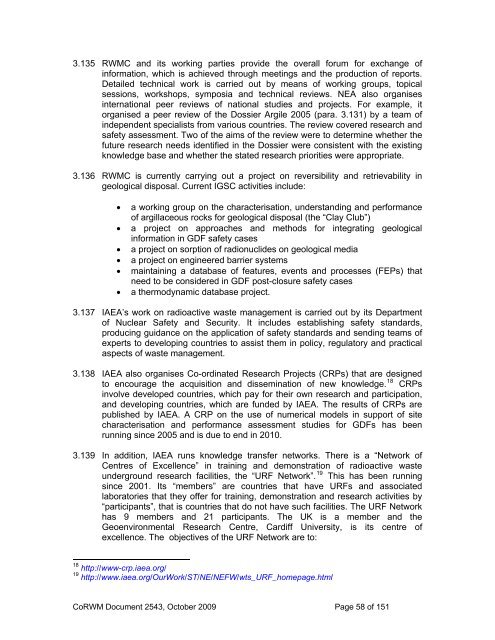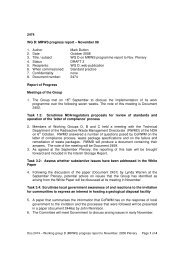2009 Report to Government on National Research and
2009 Report to Government on National Research and
2009 Report to Government on National Research and
- TAGS
- corwm.decc.gov.uk
You also want an ePaper? Increase the reach of your titles
YUMPU automatically turns print PDFs into web optimized ePapers that Google loves.
3.135 RWMC <strong>and</strong> its working parties provide the overall forum for exchange of<br />
informati<strong>on</strong>, which is achieved through meetings <strong>and</strong> the producti<strong>on</strong> of reports.<br />
Detailed technical work is carried out by means of working groups, <str<strong>on</strong>g>to</str<strong>on</strong>g>pical<br />
sessi<strong>on</strong>s, workshops, symposia <strong>and</strong> technical reviews. NEA also organises<br />
internati<strong>on</strong>al peer reviews of nati<strong>on</strong>al studies <strong>and</strong> projects. For example, it<br />
organised a peer review of the Dossier Argile 2005 (para. 3.131) by a team of<br />
independent specialists from various countries. The review covered research <strong>and</strong><br />
safety assessment. Two of the aims of the review were <str<strong>on</strong>g>to</str<strong>on</strong>g> determine whether the<br />
future research needs identified in the Dossier were c<strong>on</strong>sistent with the existing<br />
knowledge base <strong>and</strong> whether the stated research priorities were appropriate.<br />
3.136 RWMC is currently carrying out a project <strong>on</strong> reversibility <strong>and</strong> retrievability in<br />
geological disposal. Current IGSC activities include:<br />
• a working group <strong>on</strong> the characterisati<strong>on</strong>, underst<strong>and</strong>ing <strong>and</strong> performance<br />
of argillaceous rocks for geological disposal (the “Clay Club”)<br />
• a project <strong>on</strong> approaches <strong>and</strong> methods for integrating geological<br />
informati<strong>on</strong> in GDF safety cases<br />
• a project <strong>on</strong> sorpti<strong>on</strong> of radi<strong>on</strong>uclides <strong>on</strong> geological media<br />
• a project <strong>on</strong> engineered barrier systems<br />
• maintaining a database of features, events <strong>and</strong> processes (FEPs) that<br />
need <str<strong>on</strong>g>to</str<strong>on</strong>g> be c<strong>on</strong>sidered in GDF post-closure safety cases<br />
• a thermodynamic database project.<br />
3.137 IAEA’s work <strong>on</strong> radioactive waste management is carried out by its Department<br />
of Nuclear Safety <strong>and</strong> Security. It includes establishing safety st<strong>and</strong>ards,<br />
producing guidance <strong>on</strong> the applicati<strong>on</strong> of safety st<strong>and</strong>ards <strong>and</strong> sending teams of<br />
experts <str<strong>on</strong>g>to</str<strong>on</strong>g> developing countries <str<strong>on</strong>g>to</str<strong>on</strong>g> assist them in policy, regula<str<strong>on</strong>g>to</str<strong>on</strong>g>ry <strong>and</strong> practical<br />
aspects of waste management.<br />
3.138 IAEA also organises Co-ordinated <strong>Research</strong> Projects (CRPs) that are designed<br />
<str<strong>on</strong>g>to</str<strong>on</strong>g> encourage the acquisiti<strong>on</strong> <strong>and</strong> disseminati<strong>on</strong> of new knowledge. 18 CRPs<br />
involve developed countries, which pay for their own research <strong>and</strong> participati<strong>on</strong>,<br />
<strong>and</strong> developing countries, which are funded by IAEA. The results of CRPs are<br />
published by IAEA. A CRP <strong>on</strong> the use of numerical models in support of site<br />
characterisati<strong>on</strong> <strong>and</strong> performance assessment studies for GDFs has been<br />
running since 2005 <strong>and</strong> is due <str<strong>on</strong>g>to</str<strong>on</strong>g> end in 2010.<br />
3.139 In additi<strong>on</strong>, IAEA runs knowledge transfer networks. There is a “Network of<br />
Centres of Excellence” in training <strong>and</strong> dem<strong>on</strong>strati<strong>on</strong> of radioactive waste<br />
underground research facilities, the “URF Network”. 19 This has been running<br />
since 2001. Its “members” are countries that have URFs <strong>and</strong> associated<br />
labora<str<strong>on</strong>g>to</str<strong>on</strong>g>ries that they offer for training, dem<strong>on</strong>strati<strong>on</strong> <strong>and</strong> research activities by<br />
“participants”, that is countries that do not have such facilities. The URF Network<br />
has 9 members <strong>and</strong> 21 participants. The UK is a member <strong>and</strong> the<br />
Geoenvir<strong>on</strong>mental <strong>Research</strong> Centre, Cardiff University, is its centre of<br />
excellence. The objectives of the URF Network are <str<strong>on</strong>g>to</str<strong>on</strong>g>:<br />
18 http://www-crp.iaea.org/<br />
19 http://www.iaea.org/OurWork/ST/NE/NEFW/wts_URF_homepage.html<br />
CoRWM Document 2543, Oc<str<strong>on</strong>g>to</str<strong>on</strong>g>ber <str<strong>on</strong>g>2009</str<strong>on</strong>g> Page 58 of 151



